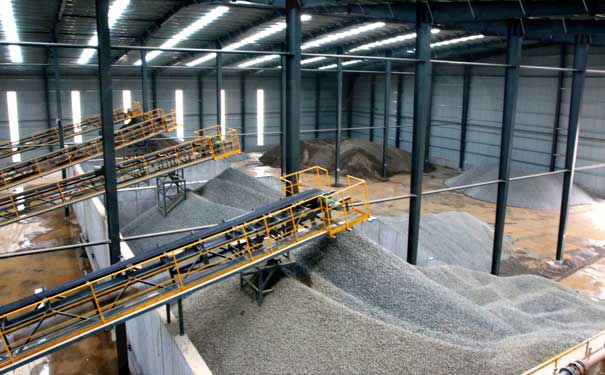The process setting and equipment selection of the aggregate production line is an important part of the production of modern aggregate mines. The sand and gravel aggregate production line not only considers the topography of the production line and the surrounding environment, but also considers the silo or silos of the gravel aggregate to ensure the efficient operation of the sand aggregate production line. The silo plays the role of transfer, buffer and adjustment in the production line. It is precisely because of the existence of the silo that the crushing equipment can discharge continuously, evenly and smoothly, and the production process can proceed in an orderly and stable manner. This article shares the key points of silo design.
1. Raw material warehouse
The raw material silo is usually a square funnel cone, surrounded by steel plates welded, and the feeder uses the height difference to make the material enter under the action of the gravitational potential energy, so that the bulk of the raw material enters, and the natural sand is separated, but it must be noted that the terrain must be used build a feeding table to ensure the entry of raw materials.
2. Transit warehouse
From the literal meaning of the transfer warehouse, we know that its role is to transfer, usually a steel structure, used to temporarily store the semi-finished products crushed by the jaw crusher, and then transfer them to the medium crushing, because the thickness, medium and fine are mixed together. So there must be a transit warehouse. The storage capacity of the warehouse is usually sufficient for the subsequent machine operation for 2-3 hours. In the case of medium and fine crushing, there is usually no transfer warehouse, which is set up when necessary in actual production.
3. Stable silo
The function of the stabilizing silo is to play a buffer. For example, the cone crusher needs a stable and even feeding, which can ensure that the crushing cavity is full, and this will also effectively protect the crusher. In addition, there are multiple equipments in one unit, and only one silo is used to evenly feed all equipments, saving belt erection.
4. Product warehouse
The product warehouses are mostly rectangular workshops, which are divided into different product rooms by partition walls. High concrete retaining walls are recommended for the partition walls. The products are sent to the corresponding product rooms by belt conveyors and can be stacked directly against the wall, greatly increasing the finished product warehouse. The storage capacity makes full use of the space under the condition of relatively saving investment; at the same time, the hardening space of the product warehouse for loading should be enlarged as much as possible to facilitate the loading operation, while leaving enough buffer area for the stacking area.
The above four kinds of silos are more common in crushed stone production lines, and production lines with different capacities and different designs may be equipped with specific silos according to the actual situation. You are welcome to consult online or call, and we have dedicated technicians to answer your questions! You are also welcome to visit the factory for consultation, or visit the production line site!




